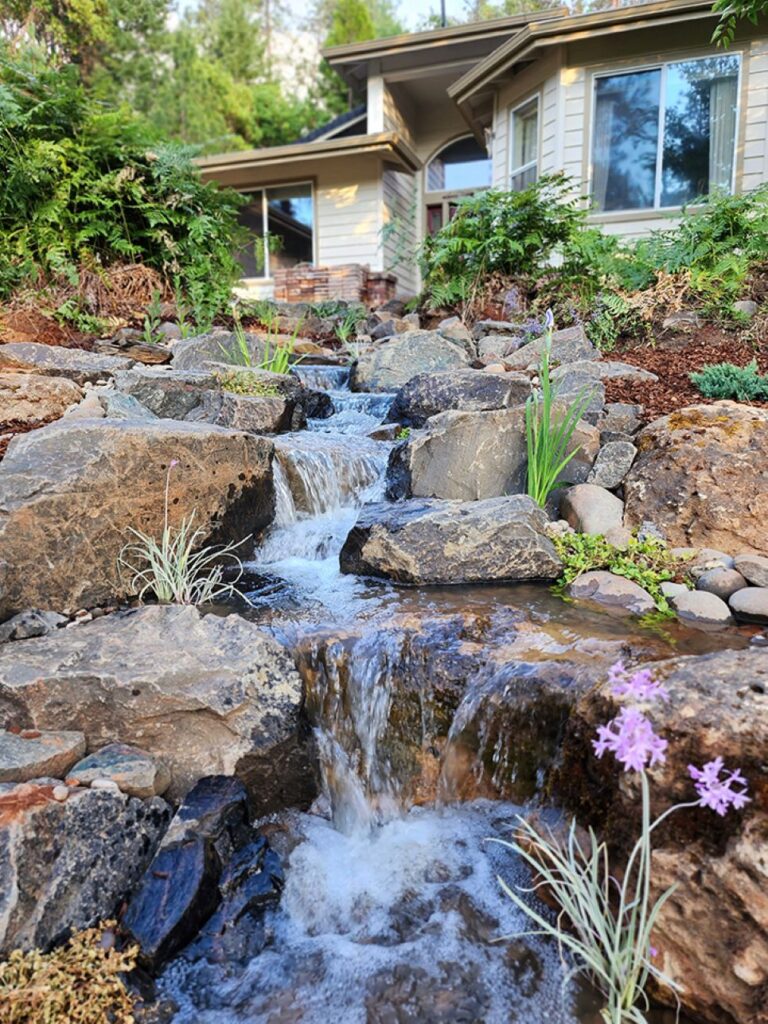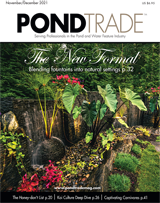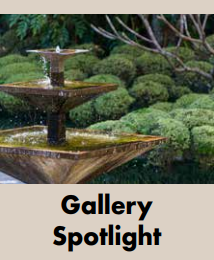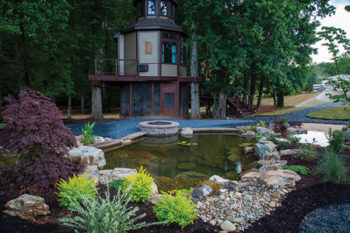Cascading pondless waterfall welcomes visitors at Rogue Valley home

After the future client had tried to complete a pondless waterfall on his own, his wife reached out in hopes of getting his beloved front yard dream waterfall completed before Father’s Day.
The feature was to be built on a gorgeous hill just below the front door of the home, looking out across a long, meandering driveway that led up to the property. We used existing boulders on site and brought in 16 tons of black basalt to complete this build. Some of the boulders were too large for the machine on site to set with straps safely, so we had to maneuver them into the wing walls.
The client attempted to use a water storage container typically used for livestock. This tank really had no space for water to enter and caused a bottleneck at the start of the stream. He also had purchased a PVC tarp to use as the liner. Unfortunately for him, he did not use underlayment or a rock pad and had multiple catastrophic holes all along the liner. This is one of the reasons why we only use 45-mil EPDM liner on every feature we build, along with non-woven geotextile fabric or sufficient rock pad, depending on the rock size.
Waterfall Construction

After ripping out the old stone, liner and water container, we began to excavate the basin. Most of the soil we dug out was spread out evenly where we knew we would be digging the shelves for the waterfall. We did this because the hill had an uneven grade, which would make building a natural falls difficult. Keeping an even grade would allow us more flexibility with the stone and would give us the ability to create pooling areas inside the feature. We knew that wildlife would be visiting this feature, so making accessible areas for them to bathe and drink was a priority. With the excavation complete, we began to construct the 250-gallon basin using 15 AquaBlox and a pump vault.
Unfortunately, the excavation had more rock and gravel than anticipated, so we used sand as a base to protect the basin liner. We over-excavated, then applied a half yard of sand and leveled before we were ready to begin putting the blocks together.
Thankfully, with sand and double layers of underlayment in place, the basin construction went quickly. We cut one of the AquaBlox to sandwich the pump vault inside the basin. We like to run them this way so that the edges of the basin are easily compacted. And with the size of rock we would be building with, we were not going to take any chances. Additionally, we used extra AquaBlox panels as supports for the boulders placed on top of the basin. Sometimes we like to use other panels to support large stones, but we knew from experience that the additional AquaBlox panels were going to get the job done.
Once the basin was complete, it was smooth sailing from there. The black basalt in this area has so much character and definition that they almost seemed to be throwing themselves into place. We layered out the falls accordingly, taking into consideration the viewpoint of the driveway. The Aquascape 5000-9000 Solids Handling Pump would give us a lot of flexibility with the waterfall weir widths, but we decided to keep the weirs at a 2-foot maximum to maximize the whitewater action. Along with deeper pools, the guttural low-end sounds would be heard from all angles.
The first falls was slightly split with a slide on the right. The second falls was cut back and split, almost unviewable until you get a bit closer. We really like to add these features so that it encourages curiosity and beckons viewers to come closer to discover. This is also a common fall type you can find in the Rogue Valley, and we like to recreate as much as we can find out in nature.
Each layer of the falls was backfilled to scale. We prefer to build this way instead of pre-digging the shelves so that we have more flexibility with rock choice. The last thing we want is to be handcuffed to the excavation. This way, we could build the hill backward without the risk of appearing as if the waterfall is popping up out of the ground.
With a few pools in between, each weir is placed opposite the last, with monstrous boulders tucking away the joints and exposing just enough so that the water appears as though it has carved away the stone itself. Placing a few boulders just in the way allows us to force water on the outside and create turbulence and even more whitewater. It also gives the illusion of twisting without having to give up too much liner.
Unfortunately, we only budgeted a 10-foot-wide liner for this project, so wide twists and turns were not possible. But we persevered and finished the top section of falls with kickbacks and a few double drops, utilizing one large-frame rock to build two separate falls. This is a favorite of ours as well, since less rock will always look better.
We buried the 3-inch flex pipe all the way to the top and used a 3-inch bulkhead to set our spillway. Instead of using a traditional spillway, which would risk losing water flow, we created a small chamber at the base of the last remaining falls. This way, the water appears as though it is bubbling out of a spring in the hillside. Sometimes this can be tricky if you don’t prop up the edges of the bulkhead property. They can tend to leak if they are pressed down, creating folds.
Finishing Touches on the Waterfall
After we were finished, we skillfully hid the edges between wing walls, gravel, large cobbles and soil. Mixing up your edging is the best way to naturalize a feature. We tend to use wood in our features, but due to burn bans, we were not able to cut down a tree. Luckily, there were no fires going at the time, and we had a clean, clear sky to work underneath.
Once the feature was complete, we surprised the client with a few marginal plants to finalize the look. Initially, the client was going to get their own mulch for the feature, but after we were finished, they asked us to mulch and plant the feature.
Now they are in the process of building a gazebo at the bottom of the hill so they can spend time next to it and enjoy it more often. You can watch a full video of the build on our YouTube channel: https://youtu.be/wxTDRUAtQ5o?si=X7z1QPqN-gZE-162







